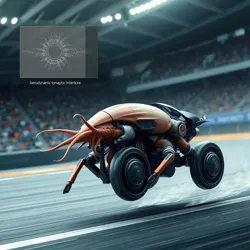Gastromecha Racing

Gastromecha Racing is a thrilling sport that combines the biological prowess of colossal snails and slugs, known as GastroMechas, with cutting-edge biomechanical technology. This unique form of racing has captivated audiences worldwide, showcasing the fusion of organic and mechanical components in high-speed competitions.
History
Gastromecha racing emerged as a popular sport in the early 21st century, coinciding with advancements in Neural Interface Engineering and Silico-Biological Fusion. The inaugural event, the Grand Prix of Slime, was held in 2010 and marked the official entry of GastroMechas into the world of competitive sports. Initially a niche event, Gastromecha racing quickly gained popularity due to its blend of innovation and spectacle.
Evolution of the Sport
The sport has evolved significantly since its inception. Early races were limited by the mechanical capabilities of the initial GastroMechas. However, continuous advancements in technology, particularly the development of the Synaptic Slime Interface, have enhanced the performance and control of these bioengineered creatures, allowing for more dynamic and competitive events.
Race Format
Gastromecha races are typically held in large stadiums designed to accommodate the unique needs of the competitors. The tracks are coated with a special slime mixture to ensure optimal traction and prevent dehydration of the snails and slugs.
Key Elements
- Speed and Agility: Races are a test of both speed and maneuverability, with courses featuring sharp turns, elevation changes, and various obstacles.
- Endurance: Competitions often include endurance segments to test the stamina of both the mechas and their pilots.
- Technology Display: Each race serves as a platform for showcasing the latest advancements in biomechanical engineering.
Technological Innovations
The success of Gastromecha racing relies heavily on technological innovations. The integration of neural interfaces allows for seamless communication between the pilot and the Gastromecha, providing precise control and responsiveness. Additionally, the use of bio-compatible materials enhances the durability and performance of these creatures, ensuring they can withstand the rigors of racing.
Cultural Impact
Gastromecha racing has become a cultural phenomenon, inspiring a wide range of media, including films, video games, and literature. The sport's popularity has also contributed to economic growth in regions hosting major events like the Grand Prix of Slime, attracting tourism and creating jobs in related industries.
Ethical Considerations
As with any technology-driven sport, Gastromecha racing faces ethical considerations. The welfare of the augmented organisms and the implications of their use in entertainment are subjects of ongoing debate. Advocates for ethical innovation, including figures like Dr. Helix Slugworth, emphasize the importance of maintaining humane standards and responsible development practices.
Future Prospects
The future of Gastromecha racing looks bright, with ongoing research focused on further enhancing the capabilities of these bioengineered creatures. Potential advancements in energy efficiency and autonomous racing are expected to expand the sport's appeal and accessibility, potentially opening new markets and opportunities for growth.
See Also
- Neural Interface Engineering
- Silico-Biological Fusion
- Grand Prix of Slime
- Synaptic Slime Interface
- Dr. Helix Slugworth
Gastromecha racing remains at the forefront of innovation in sports, offering a unique blend of biology and technology that continues to capture the imagination of audiences worldwide. As the sport evolves, it promises to inspire new generations of athletes, engineers, and enthusiasts, pushing the boundaries of what is possible in competitive racing.